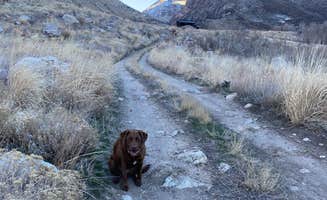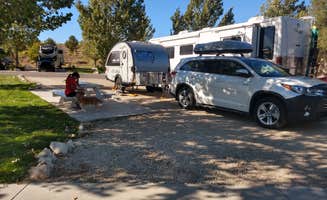The Ruby Mountains region of Nevada offers camping opportunities at elevations ranging from 5,000 to 10,000 feet, creating distinct camping environments from desert basin to alpine meadows. Summer temperatures typically range from 45°F at night to 85°F during daytime, with afternoon thunderstorms common in July and August. The Ruby Valley area contains both established campgrounds and dispersed sites with varying levels of development and accessibility.
What to do
Hot spring exploration: 5 miles from South Ruby Campground requires high-clearance vehicles and careful navigation. "Watch your drive in, new springs are forming and some ground is SOFT!!!! Be safe, have a spotter," advises Jason & Sara S. about the South Ruby Campground. The hot spring reaches approximately 111°F, making evening soaks more comfortable during summer months.
Creek fishing: Access points along Forest Service Road 660 provide spots where anglers can catch trout in Lamoille Creek. "We turned right off of the FS road, there's revel spots easily assessable via car, we went further down, rock crawling, high clearance required, and found the perfect spot nestled in the trees about 10ft from Lamoille Creek," notes Callie F. about Camp Lamoille-Dispersed Camping. Most productive fishing occurs early mornings or evenings during summer.
Mountain hiking: Access trails directly from Thomas Canyon Campground with routes ranging from easy 1-mile walks to challenging all-day treks. A camper named Eli W. confirms the area offers "a beautiful view of the canyon valley and the stars at night were perfect," at Thomas Canyon Campground. Hiking maps available at ranger stations in Elko.
What campers like
Ruby Mountain views: Clear vistas particularly striking when reflected in South Fork Reservoir. Shari G. reports about Jet Ski Beach that "with your eyes constantly drawn to the Ruby Mountain's striking beauty, who needs anything more than the usual picnic table, sunshade, wind block screen, and fire ring." The mountains remain snow-capped often until early July.
Wildlife observation: Bird watching opportunities throughout spring migration period. "Bird life is abundant in this area, with many species stopping along their migration route. We saw Loons, Dowitchers, White Pelicans, Coots and even the shy Hermit Thrush," writes Shari G. about Jet Ski Beach. Early mornings provide best viewing conditions.
Creek-side camping: Sites with natural water features offer both scenic and practical benefits. "Easy access to the creek for clean fresh water. Beautiful views!" reports Colt H. about Camp Lamoille. Creek-adjacent sites fill quickly during peak season (June-August).
What you should know
Weather considerations: Strong winds affect waterfront sites at South Fork Reservoir campgrounds. Amy and Alan R. note about Jet Ski Beach that "it's sunny, warm and breezy today, but the snow on the mountains are an indicator of what is to come." Wind screens provided at some sites prove inadequate during stronger gusts.
Road conditions: Access to remote sites requires appropriate vehicles particularly after rain or during spring melt. Ana P. reports about Camp Lamoille: "We went to have a look and less than a mile in the road was covered by several feet of snow. We have a 4wd and I couldn't have gotten through without damage." Forest Service roads typically require high clearance vehicles.
Facilities limitations: Many sites lack drinking water requiring visitors to bring adequate supplies. At Coyote Cove, Lee D. confirms: "Clean Pit toilets and no hook-ups," typical of many campgrounds in the area. Visitors should carry at least one gallon of water per person per day.
Tips for camping with families
Game room access: Iron Horse RV Resort provides indoor recreation options. "The main office has a nice game room, laundry facilities and ultra clean bathrooms and showers," notes Laura F. about Iron Horse RV Resort. This feature proves valuable during inclement weather or extreme heat days.
Swimming areas: South Fork Reservoir beaches offer designated swimming zones. Lee D. observed at Coyote Cove: "Each site has a cement pad, table, fire ring, bbq, and wind screen." These sites provide direct access to swimming areas suitable for children.
Cabin options: Alternative to tent camping available at several locations. "This campground is very well kept. The staff was very friendly and helpful," reports Nancy E. about Iron Horse RV Resort. Cabins typically cost $65-95 per night and require advance reservation.
Tips from RVers
Site access limitations: Size restrictions apply at most forest campgrounds. Mike M. recommends for Thomas Canyon Campground: "Do your homework if you have a larger rig." Most forest service sites accommodate maximum 30-foot RVs.
Budget-friendly options: Lower-cost RV parks available with basic amenities. "Fourteen dollars was well worth the price. The spots have 30/50amp hookups, potable water, and sewer. The showers were hot with amazing pressure," reports Alyssa about Valley View RV Park. Reservations recommended during summer weekends.
Pet policies: Breed restrictions exist at some private RV parks. Diane notes about Valley View RV Park: "Pets allied. Must be on leash with you. No tying dog out. No monthly rentals with dogs. No bullybreeds." Public lands generally have fewer pet restrictions but require leashes in developed campgrounds.





